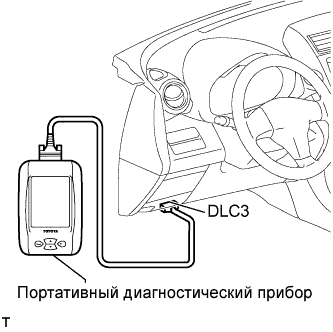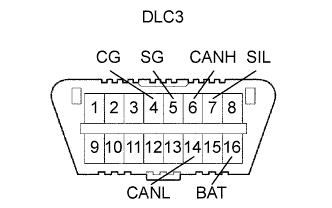Ecd System Diagnosis System
DESCRIPTION
NORMAL MODE AND CHECK MODE
2 TRIP DETECTION LOGIC
Data Link Connector 3 (DLC3)
INSPECT BATTERY VOLTAGE
CHECK MIL
ALL READINESS
Ecd System -- Diagnosis System |
When troubleshooting Europe On-Board Diagnostic (Euro-OBD) vehicles, the vehicle must be connected to an OBD scan tool (complying with ISO 15765-4). Various data output from the vehicle's ECM can then be read.
Euro-OBD regulations require that the vehicle's on-board computer illuminate the Malfunction Indicator Lamp (MIL) on the instrument panel when the computer detects a malfunction in:
The emission control system components
The powertrain control components (which affect vehicle emissions)
The computer
In addition, if the applicable Diagnostic Trouble Codes (DTCs) prescribed by ISO 15765-4 are recorded in the ECM memory. If the malfunction does not reoccur in 3 consecutive trips, the MIL turns off automatically but the DTCs remain recorded in the ECM memory.
To check DTCs, connect the intelligent tester or OBD scan tool to the Data Link Connector 3 (DLC3) of the vehicle.
The scan tool displays DTCs, the freeze frame data and a variety of engine data.
The DTCs and freeze frame data can be erased the scan tool (see page RAV4_ACA30 RM000000PDK01GX.html).
| NORMAL MODE AND CHECK MODE |
The diagnosis system operates in "normal mode" during normal vehicle use. In normal mode, "2 trip detection logic" is used to ensure accurate detection of malfunctions. "Check mode" is also available to technicians as an option. In check mode, "1 trip detection logic" is used for simulating malfunction symptoms and increasing the system's ability to detect malfunctions, including intermittent malfunctions (intelligent tester only).
When a malfunction is first detected, the malfunction is temporarily stored in the ECM memory (1st trip). If the same malfunction is detected again after the ignition switch is turned off and then on (IG), the MIL illuminated.
| Data Link Connector 3 (DLC3) |
The battery ECU uses the ISO 15765-4. The terminal arrangement of the DLC3 complies with ISO 15031-3 and matches the ISO 15765-4 format.
If the result is not as specified, the DLC3 may have a malfunction. Repair or replace the harness and connector.
Symbols (Terminal No.)
| Terminal Description
| Condition
| Specified Condition
|
SIL (7) - SG (5)
| Bus "+" line
| During transmission
| Pulse generation
|
CG (4) - Body ground
| Chassis ground
| Always
| Below 1 Ω
|
SG (5) - Body ground
| Signal ground
| Always
| Below 1 Ω
|
BAT (16) - Body ground
| Battery positive
| Always
| 9 to 14 V
|
CANH (6) - CANL (14)
| HIGH-level CAN bus line
| Ignition switch off*
| 54 to 69 Ω
|
CANH (6) - Battery positive
| HIGH-level CAN bus line
| Ignition switch off*
| 1 MΩ or higher
|
CANH (6) - CG (4)
| HIGH-level CAN bus line
| Ignition switch off*
| 200 Ω or higher
|
CANL (14) - Battery positive
| LOW-level CAN bus line
| Ignition switch off*
| 1 MΩ or higher
|
CANL (14) - CG (4)
| LOW-level CAN bus line
| Ignition switch off*
| 200 Ω or higher
|
- УКАЗАНИЕ:
- *: Before measuring the resistance, leave the vehicle as is for at least 1 minute and do not operate the ignition switch, other switches or doors.
- УКАЗАНИЕ:
- Connect the cable of the intelligent tester to the DLC3, turn the ignition switch on (IG) and attempt to use the tester. If the display indicates that a communication error has occurred, there is a problem either with the vehicle or with the tester.
- If communication is normal when the tester is connected to another vehicle, inspect the DLC3 of the original vehicle.
- If communication is still not possible when the tester is connected to another vehicle, the problem may be in the tester itself. Consult the Service Department listed in the tester's instruction manual.
If the voltage is below 11 V, replace the battery before proceeding to the next step.
- Battery voltage:
- 11 to 14 V
Check that the MIL illuminates when the ignition switch is turned on (IG).
If the MIL does not illuminate, there is a problem in the MIL circuit (see page RAV4_ACA30 RM000000WZ100YX.html).
When the engine is started, the MIL should turn OFF.
For this vehicle, using the intelligent tester allows readiness codes corresponding to all DTCs to be read. When diagnosis (normal or malfunctioning) is completed, readiness codes are set.


